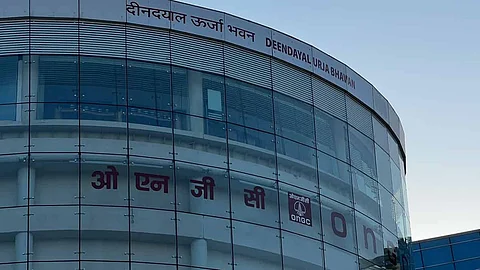

New Delhi: Oil and Natural Gas Corporation (ONGC) reported on Tuesday an 18.2 percent year-on-year (YoY) rise in consolidated net profit to Rs 11,554 crore for the quarter ended June 30, supported by contributions from subsidiaries such as Hindustan Petroleum Corporation Ltd (HPCL) and Mangalore Refinery and Petrochemicals Ltd (MRPL). However, its standalone business faced headwinds from weaker crude price realisations.
Follow Energy Watch on X
Standalone net profit fell 10.2 percent YoY to Rs 8,024 crore, with gross revenue dropping 9.3 percent to Rs 32,003 crore. Average net realisation for nominated crude oil declined sharply by 20.4 percent to USD 66.13 per barrel from USD 83.05 a year earlier, while JV crude oil realisation fell 15.8 percent to USD 67.87 per barrel. In rupee terms, nominated crude realisation fell to Rs 5,658/bbl from Rs 6,928/bbl, reflecting both lower prices and currency effects.
The fall in realisations outpaced the 1.2 percent increase in standalone crude oil output to 4.683 million metric tonnes (MMT). Standalone natural gas production was nearly flat at 4.846 billion cubic metres (BCM).
ONGC’s net profit margin on a standalone basis narrowed to 25.07 percent in Q1 FY26 from 25.34 percent in the year-ago period, while the operating margin was almost flat at 37.08 percent. Sequentially, however, both margins improved from Q4 FY25’s net profit margin of 18.43 percent and operating margin of 28.46 percent, aided by lower exploration costs and other expenses.
The company’s focus on premium-priced “new well gas” provided a partial offset to lower oil prices. Gas from these wells, eligible for a 20 percent premium over the domestic administered price mechanism (APM) rate, generated Rs 1,703 crore in revenue — Rs 333 crore higher than it would have under APM rates. ONGC said it is actively working to boost output from such wells to enhance returns.
On a consolidated basis, gross revenue fell 3.5 percent YoY to Rs 1,63,108 crore, but net profit rose 18.2 percent to Rs 11,554 crore, underscoring the cushioning effect of integrated operations. Profit attributable to owners, however, slipped 1.7 percent to Rs 9,804 crore, indicating some pressure in the parent’s own earnings stream.
The higher consolidated profit despite weaker topline reflects improved refining margins, marketing gains, and stable overseas operations through ONGC Videsh. It also points to the group’s diversification benefits in a volatile commodity price environment.
ONGC made two offshore hydrocarbon discoveries — “Vajramani” in the Mahuva Formation and “Suryamani” in the Mukta Formation — in Mumbai Offshore, with initial flow rates indicating commercial potential. The quarter also saw the commencement of production from the PY-3 field in the Cauvery Basin, gas sales from the North Karanpura block in Jharkhand, and the commissioning of an alkaline surfactant polymer (ASP) plant at Ahmedabad Asset to enhance oil recovery.
The board also approved a Rs 4,963 crore investment to set up a 0.6 GW renewable energy project (300 MW each of solar and wind) by 2028 under a group captive model. ONGC said this will lower operational costs while supporting its ESG commitments.
Director (Finance) Vivek Chandrakant Tongaonkar said the results demonstrate “the resilience of ONGC’s integrated business model” and highlighted that “our strategic investments in enhanced oil recovery, premium gas production and renewable energy will underpin long-term growth, even in a volatile pricing environment.”
Follow Energy Watch on LinkedIN
While global crude benchmarks have softened from last year’s highs, ONGC’s margins are showing sequential recovery due to cost control, production efficiency gains and high-margin gas output. However, the company continues to face litigation-related contingent liabilities, including Rs 13,890 crore linked to the Panna-Mukta and Tapti fields arbitration and over Rs 5,300 crore in partner and penalty disputes on service tax/GST on royalty.
